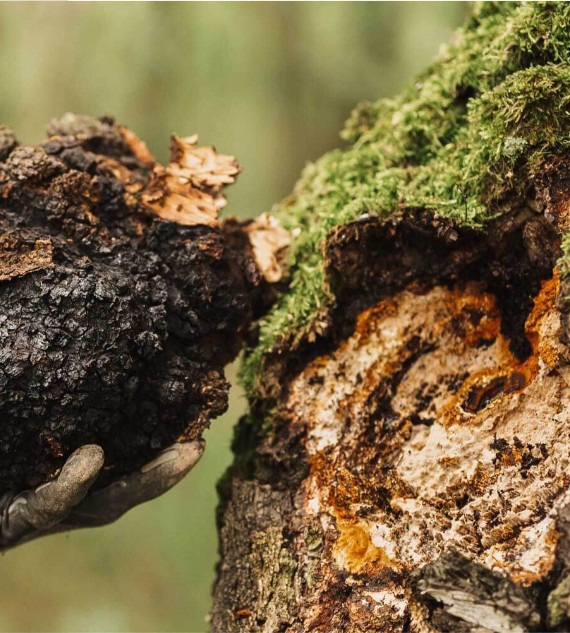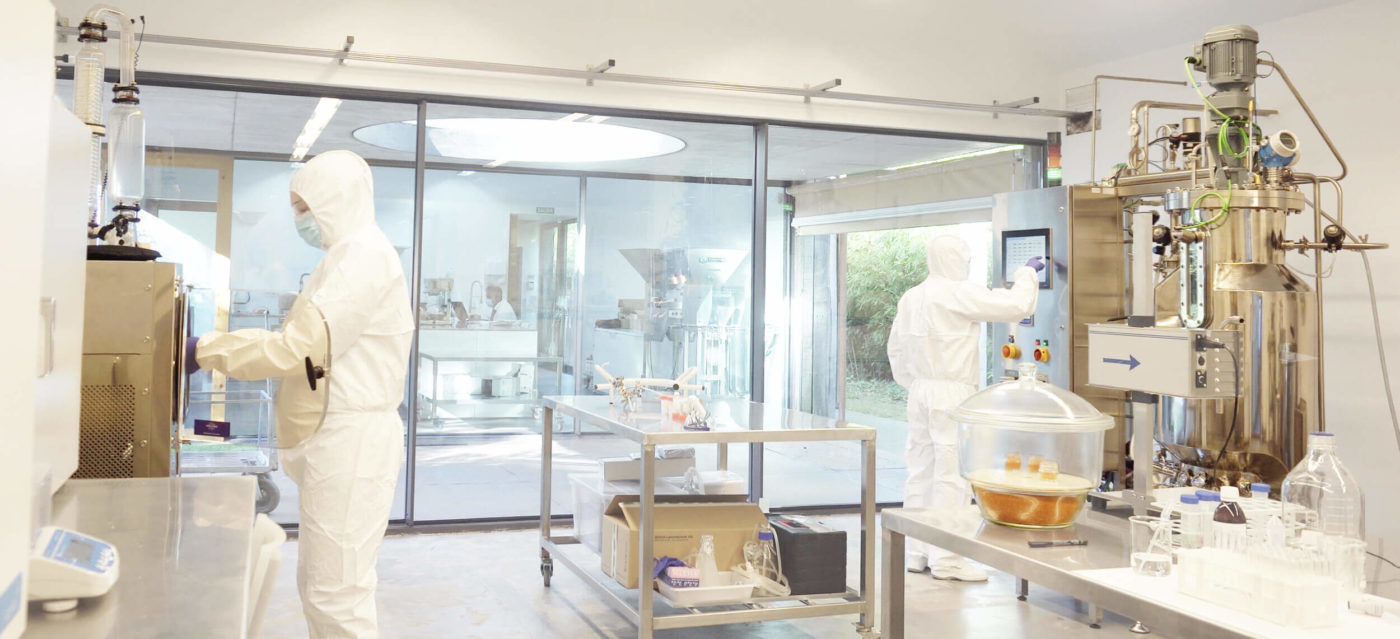Chaga
Chaga (Inonotus obliquus) is a mycological species with a long tradition of use in Siberian medicine, where it was used to treat intestinal, liver and heart problems. Since the 1960s, studies have been carried out on its effect on oncological processes, and cardiovascular and chronic diseases.
I. obliquus, popularly known as ‘Chaga’ or ‘Tsyr’, is a medicinal mushroom that grows naturally in the northernmost forests of the European continent. Due to its black colour and the immunomodulatory and antioxidant properties of the polysaccharides it contains, it is known as the ‘black pearl’ or ‘diamond of the forest’.se
ESSENTIAL NOTES ON THE ‘BLACK PEARL’
The Chaga medicinal mushroom stands out for its quantity and variety of polysaccharides, immunomodulatory substances of interest for the immune system. It also contains betulinic acid, which has been studied in various areas:
- Cardiovascular Health: supports the heart due to its betulinic acid content.
- Immunology: chaga’s effect on immune cells and the immune system as a whole have shown positive results.
Documentation shows that Chaga has been used for centuries in traditional medicine in northern Europe, where, like turkey tail, it was recommended for consumption in infusions made from concentrated powder boiled in water (zavarka), in this case to ‘treat intestinal ailments and liver and heart problems’. In the 1960s, Finnish, American and Russian scientists carried out various research projects and studied the action of chaga extracts in oncological processes, and cardiovascular and chronic diseases.

PROPERTIES, APLICATIONS AND USES OF CHAGA
In the West, following these studies, and the publication in 1968 of the work Cancer Pavilion, by the Russian Nobel Prize winner Aleksandr Solzhenitsyn, it became a very popular mushroom. Both previous studies and historical references in this work made it known as the ‘black pearl’ or the ‘diamond of the woods’, among other terms.
Empirical scientific evidence has now established that chaga contains a significant amount of polysaccharides, inotodiol, betulin and betulinic acid. Controlled cultivation is the favoured method of production so that these active substances can be extracted and used for various clinical applications. An extract is the most concentrated form in which the active biomolecules of Chaga can be found. This can be standardised in powder form (Mico-Five), but can also be found in liquid form in infant formulas such as Dr. Immune Five.
Extracts are best produced using sustainable technologies, which do not denature the compounds naturally occuring in chaga. The result of this process is a higher concentration of its substances of therapeutic interest and, therefore, a better use of these. In addition, standardisation of extracts ensures a consistent quantity and quality of polysaccharides, terpenes, zinc, etc. in each batch produced.
PROPERTIES, APPLICATIONS AND USES OF CHAGA
In the West, following these studies, and the publication in 1968 of the work Cancer Pavilion, by the Russian Nobel Prize winner Aleksandr Solzhenitsyn, it became a very popular mushroom. Both previous studies and historical references in this work made it known as the ‘black pearl’ or the ‘diamond of the woods’, among other terms.
Empirical scientific evidence has now established that chaga contains a significant amount of polysaccharides, inotodiol, betulin and betulinic acid. Controlled cultivation is the favoured method of production so that these active substances can be extracted and used for various clinical applications. An extract is the most concentrated form in which the active biomolecules of Chaga can be found. This can be standardised in powder form (Mico-Five), but can also be found in liquid form in infant formulas such as Dr. Immune Five.
Extracts are best produced using sustainable technologies, which do not denature the compounds naturally occuring in chaga. The result of this process is a higher concentration of its substances of therapeutic interest and, therefore, a better use of these. In addition, standardisation of extracts ensures a consistent quantity and quality of polysaccharides, terpenes, zinc, etc. in each batch produced.
PRODUCTS WITH CHAGA
CHAGA NUTRIENT HIGHLIGHTS
ERGOSTEROL
MINERALS:
Calcium
Potassium
Manganese
Copper
MINERALS:
betulinic acid
HABITAT AND DISTRIBUTION
In northern and eastern Europe, especially in Siberia, there are huge stands of birch trees, the most common substrate for Chaga. It is therefore not surprising to find wild Chaga growing in the forests of these latitudes.
MYCOLOGICAL NOTES
Chaga is a fungus that grows symbiotically on its host, a weakened birch tree, over a long period of time. This medicinal fungus can take 20-30 years to form a black tuber, which can grow up to the size of a child’s head. Interestingly, this structure does not resemble the fruiting body of a common fungus and the sclerotium is found inside the colonised birch. Both parts have a characteristic brown colour due to their high production of melanin, the same pigment that makes our skin tan in the sun.
CHAGA CULTIVATION
The cultivation of Chaga is not as simple as that of other species such as Lion’s Mane. At present, wild harvesting in Scandinavian and Siberian forests is the main source of this fungus. However, successful mycelium production techniques have been developed in bioreactors.
Our R&D research on I. obliquus has allowed us to corroborate its therapeutic benefits, especially in formulations where compounds with immunomodulatory qualities are the most important such as (Mico-Five), or the infant formula Dr. Immune Five. In addition, Chaga is considered a “relevant source of polyphenols”. Given these actions and the results observed from historical use and modern research, Chaga has recently been added to the Hifas Mycological Bank (HMB) (HdT’s bank of fungal strains), following the selection of the most suitable hyphae and the optimisation of its production and extraction.
Massima qualità, purezza e prestazioni nei nostri sistemi di produzione

Massima qualità, purezza e prestazioni nei nostri sistemi di produzione
R&D AND STUDIES ON CHAGA
- Hifas da Terra conducted an observational study at the Poal Institute of Rheumatology in Barcelona on patients diagnosed with osteoarthritis of the knee. After three months of supplementation with medicinal mushroom extracts – including the sun mushroom (Mico-Five) – the study group reported widespread improvements in pain and stiffness relief and improved energy levels.
FUN FACTS
- It is one of the most popular medicinal mushrooms in current use
- In 1955 it was recognised by the Russian Medical Research Council for the treatment of tumours, especially gastric and lung tumours
- Nobel laureate Alexandr Solzhenitsyn wrote in 1968 and 1971 about Chaga and its medicinal uses based on his experiences in Siberia
- Balandaykin ME, Zmitrovich IV: Review on Chaga medicinal mushroom, Inonotus obliquus (higher Basidiomycetes): Realm of medicinal applications and approaches on estimating its resource potential. Int J Med Mushrooms, 2015; 17(2): 95–104.
- Burmasova MA, Utabaeva AA, Sysoeva EV, Sysoeva MA: Melanins of Inonotus obliquus: Bifidogenic and antioxidant properties. Biomolecules, 2019;9(6):248.
- Досычев ЕА, Быстрова ВН: Лечение псориаза препаратами гриба “Чага”. Вестник Дерматологии и Венерологии, 1973; 5: 79–83.
- Duru KC, Kovaleva EG, Danilova IG, van der Bijl P: The pharmacological potential and possible molecular mechanisms of action of Inonotus obliquus from preclinical studies. Phytother Res, 2019;33(8): 1966–1980.
- Fan LP, Ding SD, Ai LZ, Deng KQ: Antitumor and immunomodulatory activity of water-soluble polysaccharide from Inonotus obliquus. Carbohydr Polym, 2012;90(2): 870–874.
- Geng Y, Lu ZM, Huang W, Xu YH, Shi JS, Xu ZH: Bioassay-guided isolation of DDP-4 inhibitory fractions from extracts of submerged cultured of Inonotus obliquus. Molecules, 2013;18(1): 1150–1161.
- Géry A, Dubreule C, André V, Rioult JP, Bouchart V, Heutte N, Eldin de Pécoulas P, Krivomaz T, Garon D: Chaga (Inonotus obliquus), a future potential medicinal fungus in oncology? A chemical study and a comparison of the cytotoxicity against human lung adenocarcinoma cells (A549) and human bronchial epithelial cells (BEAS-2B). Integr Cancer Ther, 2018;17(3): 832–843.
- Han ZH, Zhang JC, Liu JN, Dai XD, Kong XH, MA QF, Zhang PQ: Artificial cultivation of Inonotus obliquus. Acta Edulis Fungi, 2010;17(2): 36–42. [in Chinese]
- Javed S, Mitchell K, Sidsworth D, Sellers SL, Reutens-Hernandez J, Massicotte HB, Egger KN, Lee CH, Payne GW: Inonotus obliquus attenuates histamine-induced microvascular inflammation. PLoS ONE, 2019;14(8): e0220776.
- Liu P, Xue J, Tong SS, Dong WX, Wu PP: Structure characterization and hypoglycaemic activities of two polysaccharides from Inonotus obliquus. Molecules, 2018;23(8): pii: E1948.
- Liu ZD, Yu DS, Li L, Liu XX, Zhang HN, Sun WB, Lin CC, Chen JF, Chen Z, Wang WH, Jia W: Three-phase partitioning for the extraction and purification of polysaccharides from the immunomodulatory medicinal mushroom Inonotus obliquus. Molecules, 2019;24(3): pii: E403.
- Nomura M, Takahashi T, Uesugi A, Tanaka R, Kobayashi S: Inotodiol, a lanostane triterpenoid, from Inonotus obliquus inhibits cell proliferation through caspase-3-dependent apoptosis. Anticancer Res, 2008;28(5A): 2691–2696.
- Sagayama K, Tanaka N, Fukumoto T, Kashiwada Y: Lanostane-type triterpenes from the sclerotium of Inonotus obliquus (Chaga mushrooms) as proproliferative agents on human follicle dermal papilla cells. J Nat Med, 2019;73(3): 597–601.
- Staniszewska J, Szymański M, Ignatowicz E: Antitumor and immunomodulatory activity of Inonotus obliquus. Herba Pol, 2017;63(2): 48–58.
- Sun Y, Yin T, Chen XH, Zhang G, Curtis RB, Lu ZH, Jiang JH: In vitro antitumor activity and structure characterization of ethanol extracts from wild and cultivated Chaga medicinal mushroom, Inonotus obliquus (Pers.:Fr.) Pilát (Aphyllophoromycetideae). Int J Med Mushrooms, 2011;13(2): 121–130.
- Xue J, Tong SS, Wang ZR, Liu P: Chemical characterization and hypoglycaemic activities in vitro of two polysaccharides from Inonotus obliquus by submerged culture. Molecules, 2018;23(12): pii: E3261.
- Yong TQ, Chen SD, Liang DL, Zuo D, Diao X, Deng CL, Wu YN, Hu HP, Xie YZ, Chen DL: Actions of Inonotus obliquus against hyperuricemia through XOD and bioactives screened by molecular modelling. Int J Mol Sci, 2018;19(10): pii: E3222.
- Zhang LX, Fan C, Liu SC, Zang ZF, Jiao LL, Zhang LP: Chemical composition and antitumor activity of polysaccharide from Inonotus obliquus. J Med Plant Res, 2011;5(7): 1251–1260.
- Zheng WF, Liu T, Xiang XY, Gu Q: Sterol composition in field-grown and cultured mycelia of Inonotus obliquus. Acta Pharmacol Sin, 2007;42(7): 750–756.
- Zheng WF, Zhao YX, Zhang MM, Yin ZJ, Chen CF, Wei ZW: Phenolic compounds from Inonotus obliquus and their immune-stimulating effects. Mycosystema, 2008;27(4): 574-581.
- Isokauppila T: Healing Mushrooms : A Practical and Culinary Guide to Using Mushrooms for Whole Body Health. New York : Avery, 2017. 215 p. ISBN 978-0-7352-1602-0
- Lelley J: Die Heilkraft der Pilze : Gesund durch Mykotherapie. Düsseldorf : München : ECON Verlag GmbH, 1997. 236 p. ISBN 3-430-15953-9
- Powell M: Medicinal Mushrooms : A Clinical Guide. 2nd updated and expanded ed. Mycology Press, 2014. 152 p. ISBN 978-0-9566898-2-5
- Rogers R: The Fungal Pharmacy : The Complete Guide to Medicinal Mushrooms & Lichens of North America. Berkeley, CA : North Atlantic Books, 2011. 591 p. ISBN 978-1-55643-953-7
Chaga
Inonotus Obliquus
BLACK PEARL
Forest Diamond
TSYR
Youngzhi
